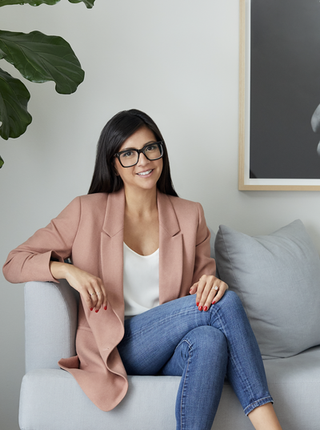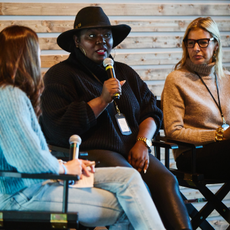The Women Reinventing the Way We Work
COVID-19 forced about two thirds of Americans to hastily pack up their offices and head to homemade workstations. Many will never go back. These six women are making WFH the new reality.


No one quite knows what the post-coronavirus, nebulous “new normal” will look like, but one thing is sure: Work is going to be different. Corporations that have long resisted work-from-home models have realized that people actually can be productive despite sitting on couches and at kitchen tables. Some companies, like Twitter and Square, have already announced that employees can work remotely indefinitely if they so choose; others seem ready to let their office leases lapse. According to one survey, 74 percent of organizations report that they plan to allow some employees to work remotely for good, and Global Workplace Analytics says up to 30 percent of the entire American workforce will likely work from home at least a couple of days a week by the end of 2021. Virtual communication tools are no longer a nicety; they’re essential. To make the “WFH forever” switch happen, the six women featured here are building, leading, and improving upon the tools we need—the emails, fax machines, and spreadsheets of the future.

SMITA HASHIM Director of Product Management, Google Meet
The G Suite (Docs! Drive! Calendar!) powers much of the C-suite. In 2017, Google’s portfolio got a little more robust when the company launched Google Meet, the sophisticated big sister of its popular videoconferencing tool Hangouts. Meet is headed by Smita Hashim, a 15-year Google veteran. Under her leadership, the formerly premium-only product was made free during the height of COVID-19 (and will stay that way forever). “From a business perspective, that was a pretty straightforward decision to make,” says Hashim. “The challenge, of course, was to provide it at such an accelerated timeline.” Hashim’s team is also developing new user-friendly features, like closed captioning in more languages than just English (plus translations) and cloud-based de-noising software, which would allow users to type an email during a Google Meet without the clicking sound of the keys registering. (Need that ASAP.) But for Hashim, more exciting than muffling the sound of multitasking is the shift she sees already unfolding in broader work culture. “I think people are learning how to use meetings as a way to connect,” she says, “not just be transactional.

ALI RAYL Vice President of Customer Experience, Slack
You have Ali Rayl to thank for killing “per my last email” culture. As vice president of customer experience at Slack, a business-approved instant-messaging platform, Rayl has the job of making the lives of more than 12 million active daily Slackers easier. Though the tool has been reinventing interoffice communication for more than 10 years (Rayl was one of Slack’s first eight employees), the platform has welcomed 12,000 new paid organizations since the onset of the pandemic. Part of Slack’s success is that it’s one of the few communication tools that support asynchronous work, meaning people don’t have to be in the same meeting at the same time. “As we know, the burden of housework and childcare still mostly falls on women,” Rayl says, noting that Slack channels are designed to foster flexible back-and-forth communication, so you can chime in on a brainstorm between walking the dog and relearning seventh-grade algebra. (Hooray for homeschooling!) To support a growing user base, Slack gave its desktop interface a remodel, released a library of templates to automate tasks, and unveiled a remote-themed emoji pack (including one that signifies Wi-Fi is down). Slack has also become a virtual workplace watercooler of sorts—even at the company itself. “We have an Animal Crossing channel, and every day someone’s like, ‘Hey, post your turnip prices in the thread,’ ” Rayl says. “That’s the way we keep social connection. That is the thing that makes humans human.”

JANINE PELOSI Chief Marketing Officer, Zoom
When your company’s name becomes a verb, you’ve officially made it. Zoom, now synonymous with videoconferencing (the service it provides), has connected millions of people across the globe—from grandmas with their families to executives with
their teams. Janine Pelosi, the company’s chief marketing officer of five years, navigated the company through it all: the unexpected massive growth (from December to April, its number of daily meeting participants grew from 10 million to 300 million per day—a 2,900 percent increase), a PR nightmare (in March, it became trendy for online trolls to “Zoombomb,” or invade a Zoom call uninvited; in response, the company built new security measures) and, of course, supporting businesses as they switch to Zoom to conduct meetings, team check-ins, client calls, and much more. The platform is only gaining popularity as more companies upgrade to the premium model, which allows for meetings longer than 40 minutes. “What I know for certain is that we’re not going to go back to the way things were before this,” Pelosi says. “What I don’t know is exactly what that’s going to look like.” It’s looking like we’ll be on Zoom

OLIVIA NOTTEBOHM Chief Operating Officer, Dropbox
Exactly one month after Olivia Nottebohm’s first day as chief operating officer of Dropbox—the platform that lets you share and collaborate on documents, presentations, spreadsheets, and more via the cloud—the company went fully remote. As the new COO, Nottebohm was supposed to have traveled to each of the 12 offices around the world. “I only got to Austin and New York,” she says. Instead, the Californian woke up in the middle of the night to hold virtual coffee meetings with offices in Japan and Australia. Tired as she was, Nottebohm still quickly led the response to an increase in demand for Dropbox, including Dropbox Business, the company’s premium extension: In the first quarter of 2020, paid users jumped 10 percent from the year before, totaling 14.6 million. Today, the service is utilized by more than 450,000 teams—from a hospital that needed 100 new accounts overnight in order to manage its inventory of supplies during the height of the pandemic to National Geographic and Ben & Jerry’s. “Businesses are finding themselves in new territory,” she says. “When they win, we win.”

ARCHANA RAO Chief Information Officer, Atlassian
Archana Rao never worked from home during her 20-year career, but as chief information officer of Atlassian, the software giant behind project-management tools like Jira and Trello, she was responsible for transitioning 4,500 employees across offices in eight countries to a remote-first model. Atlassian itself helps technology teams at more than 170,000 companies (including goliaths like General Motors, Spotify, and Verizon) collaborate and build software. Its use cases during the COVID-19 shutdown are impressive: SpaceX launched its historic astronaut rocket in May with the help of Atlassian technology, Walmart used Atlassian to help power e-commerce during the pandemic (the company reported a 74 percent jump in online sales), and St. Jude Children’s Research Hospital’s IT, research, and operations teams used Atlassian’s project-management software to help prioritize and manage employees’ work. As the demand for Atlassian’s tools has increased, Rao is preparing the company for another surge of growth—and for a future in which Atlassian products are essential to keeping the economy going. “Collaboration tools are not nice to have; they are now a necessity,” she says. “It’s a way of life.”

ERICA JOY BAKER Director of Software Engineering, GitHub
“I’ve been a computer nerd for the majority of my life,” says Erica Joy Baker, the director of software engineering at GitHub, an online community used by more than 50 million people to share programming tools, write and review code, and build high-tech solutions. Transitioning to WFH wasn’t tough for the company—around 70 percent of GitHub’s workforce was remote prior to COVID-19—but employees had their work cut out for them in helping Dow Jones, Stripe, and more pivot their projects to the collaborative model. The demand is keeping Baker busy. She’s been building a version of GitHub tailored to the security needs of large corporations, like IBM and Walmart, and helping institutions use their programs for good; Johns Hopkins University is using GitHub to power an app that tracks reported cases of COVID-19 in real time. She believes that WFH might open up opportunities for those who dream of a career in tech but not the expensive Silicon Valley lifestyle that comes with it. “Now we are seeing that remote work is possible,” she says. “People are learning differently.”
Stay In The Know
Get exclusive access to fashion and beauty trends, hot-off-the-press celebrity news, and more.
This story appears in the Fall 2020 issue of Marie Claire.
The print version of this story stated that Zoom grew from 10 million daily "users" to 300 million per day. This story has been updated to reflect that the correct term is "daily meeting participants," not "users."
Design by Hanna Varady + Rayl, Rao, Hashim, Pelosi and Nottebohm: Courtesy of the Subjects; Backgrounds (used throughout): Katsumi Murouchi (2), Aaron Foster, Arthid Huangtumluck/All Getty Images
RELATED STORIES


Megan DiTrolio is the editor of features and special projects at Marie Claire, where she oversees all career coverage and writes and edits stories on women’s issues, politics, cultural trends, and more. In addition to editing feature stories, she programs Marie Claire’s annual Power Trip conference and Marie Claire’s Getting Down To Business Instagram Live franchise.
-
 King Charles Plans to Surprise Queen Camilla With Special Gift
King Charles Plans to Surprise Queen Camilla With Special GiftThe monarch shared his not-so-secret plans with a celebrity at the Royal Variety Performance.
By Amy Mackelden Published
-
 Prince William "Appalled" at Way Kate Middleton Was Treated
Prince William "Appalled" at Way Kate Middleton Was Treated"The princess is being encouraged to ignore critics."
By Amy Mackelden Published
-
 King Charles Forced to Quit Hobby After "Too Many Injuries"
King Charles Forced to Quit Hobby After "Too Many Injuries""I can't do much now," he explained.
By Amy Mackelden Published
-
 Peloton’s Selena Samuela on Turning Tragedy Into Strength
Peloton’s Selena Samuela on Turning Tragedy Into StrengthBefore becoming a powerhouse cycling instructor, Selena Samuela was an immigrant trying to adjust to new environments and new versions of herself.
By Emily Tisch Sussman Published
-
 This Mutual Fund Firm Is Helping to Create a More Sustainable Future
This Mutual Fund Firm Is Helping to Create a More Sustainable FutureAmy Domini and her firm, Domini Impact Investments LLC, are inspiring a greater and greener world—one investor at a time.
By Sponsored Published
-
 So Your Company Is Diverse, Now What?
So Your Company Is Diverse, Now What?Morgan DeBaun, CEO and co-founder of Blavity, shares her best advice for running a multicultural company.
By Morgan DeBaun as told to Maria Ricapito Published
-
 The Competition for Creators
The Competition for CreatorsCreators hold more power than ever—and companies are taking stock.
By Rachel Epstein Published
-
 Power Players Build on Success
Power Players Build on Success"The New Normal" left some brands stronger than ever. We asked then what lies ahead.
By Maria Ricapito Published
-
 Don't Stress! You Can Get in Good Shape Money-wise
Don't Stress! You Can Get in Good Shape Money-wiseFeatures Yes, maybe you eat paleo and have mastered crow pose, but do you practice financial wellness?
By Sallie Krawcheck Published
-
 The Book Club Revolution
The Book Club RevolutionLots of women are voracious readers. Other women are capitalizing on that.
By Lily Herman Published
-
 The Future of Women and Work
The Future of Women and WorkThe pandemic has completely upended how we do our jobs. This is Marie Claire's guide to navigating your career in a COVID-19 world.
By Megan DiTrolio Published